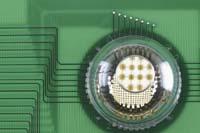A camera like eyes

The camera is the size of a human eye, is shaped like a human eye and functions as a human eye. Developed at the University of Illinois, it represents a spectacular advance. In fact, those who work in the field of optoelectronics had spent at least twenty years trying to develop something like that.
The camera, like the human eye, uses a curved lens to focus the image. In fact, the challenge was to develop photoreceptors --pixels - that did not break and deteriorate at the angle. Conventional cameras have flat surfaces, as typical silicon structures break when bending. However, conventional cameras receive the image through a lens curve, which leads them to need supplemental lenses to correct distortions that occur from the curved source to the focus point.
The challenge has been overcome at the University of Illinois, connecting silicon pixels with short metal threads and collecting the network thus created in polymers (in a polyimide). This structure is curved in the compression and the structure itself absorbs the resulting mechanical tension. Therefore, pixels are not damaged (in the image the network is the one seen in the background).
To create the camera has been added this structure to another domed, obtaining a very ordered result. The camera creator, John Rogers, believes that this system will facilitate the steps from the laboratory, as it is based on the material and technology that is already used.





